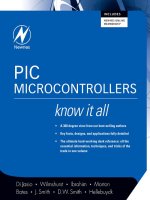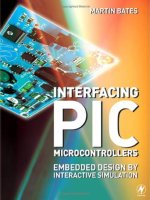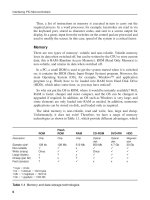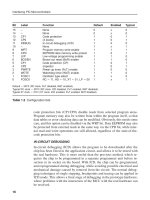Interfacing PIC Microcontrollers Embedded Design by Interactive Simulation docx
Bạn đang xem bản rút gọn của tài liệu. Xem và tải ngay bản đầy đủ của tài liệu tại đây (2.99 MB, 90 trang )
A Broadcast Engineering Tutorial
for Non-Engineers
THIRD EDITIONA Broadcast Engineering Tutorial
for Non-Engineers
THIRD EDITION
Graham Jones
National Association of Broadcasters
AMSTERDAM • BOSTON • HEIDELBERG
LONDON • NEW YORK • OXFORD • PARIS
SAN DIEGO • SAN FRANCISCO • SINGAPORE
SYDNEY • TOKYO
Focal Press is an imprint of Elsevier
Acquisition Editor: Angelina Ward
Project Manager: Kyle Sarofeen
Assistant Editor: Becky Golden-Harrell
Marketing Manager: Christine Degon
Cover Design: Eric DeCicco
Focal Press is an imprint of Elsevier
30 Corporate Drive, Suite 400, Burlington, MA 01803, USA
Linacre House, Jordan Hill, Oxford OX2 8DP, UK
Copyright © 2005, Elsevier Inc. All rights reserved.
No part of this publication may be reproduced, stored in a retrieval system, or
transmitted in any form or by any means, electronic, mechanical, photocopying,
recording, or otherwise, without the prior written permission of the publisher.
Permissions may be sought directly from Elsevier’s Science & Technology Rights
Department in Oxford, UK: phone: (+44) 1865 843830, fax: (+44) 1865 853333, e-mail:
You may also complete your request on-line via the Elsevier
homepage (), by selecting “Customer Support” and then “Obtaining
Permissions.”
Recognizing the importance of preserving what has been written, Elsevier prints its books
on acid-free paper whenever possible.
Library of Congress Cataloging-in-Publication Data
Jones, Graham.
A broadcast engineering tutorial for non-engineers / Graham Jones.—3rd
ed
p. cm.
Includes index.
ISBN 0-240-80700-6
1. Radio—Transmitters and transmission. 2. Television—Transmitters and
transmission. 3. Radio broadcasting. 4. Television broadcasting. I.
Title.
TK6561.J66 2005
621.384—dc22
2005006432
British Library Cataloguing-in-Publication Data
A catalogue record for this book is available from the British Library.
ISBN: 0-240-80700-6
For information on all Focal Press publications
visit our website at www.books.elsevier.com
050607080910 10987654321
Printed in the United States of America
Contents
Preface xi
Acknowledgments xiii
1 Introduction 1
BROADCASTING BASICS 3
2 Types of Broadcasting 5
Analog Radio 5
Digital Radio 6
Satellite Radio 8
Analog Television 9
Digital Television 10
Satellite Television 11
Cable Television 12
Groups and Networks 13
Internet Radio and Television 14
3 Sound and Vision 17
Sound and Audio 17
Light and Video 20
Baseband 22
4 Radio Frequency Waves 23
Electromagnetic Waves 23
Frequencies, Bands, and Channels 25
RF Over Wires and Cables 26
Modulation 27
v
5 Analog Color Television 33
NTSC 33
PAL and SECAM 42
HD Analog Video 43
6 Digital Audio and Video 45
Digital Audio 45
SD and HD Digital Video 52
7 Information Technology 61
Binary 61
Computers 63
Storage 65
Computer Networks 68
Internet Streaming 70
STUDIOS AND PRODUCTION FACILITIES 75
8 Radio Studios 77
Types of Studios 77
Studio Operations 78
System Considerations 81
Audio Mixing Consoles 84
Microphones 87
Loudspeakers and Headphones 89
CD Players 91
Hard Disk Recorders and Audio Workstations 92
Radio Program Automation 95
Digital Record/Playback Devices 96
Analog Devices 98
Telephone Hybrids 100
Remote Sources 101
Audio Delay Units 101
Emergency Alert System 102
Audio Processing Equipment 103
Signal Distribution 109
Ancillary Systems 111
Radio Master Control 112
Other Considerations and Capabilities 113
vi CONTENTS
9 Television Studios 117
Station and Network Operations 117
Types of Studios 119
Studio Lighting 121
Studio Control Rooms 122
System Considerations 123
Studio System 125
Video Switchers and Effects Units 127
Picture and Waveform Monitoring 130
Television Cameras 132
Film in Television 137
Videotape Recorders 140
Analog VTRs 144
Digital VTRs 145
HD Digital VTRs 149
Optical, Solid-State, and Hard Disk Recorders 151
Video Editing 152
SMPTE Timecode 153
Video Servers 154
Nonlinear Editing 156
Character Generators and Computer Graphics 158
Electronic Newsroom 159
Signal Distribution 159
Video Timing 162
Audio for Television 163
Ancillary Systems 166
Ingest and Conversion 167
Television Master Control 169
Television Automation 174
ATSC Encoding 176
Multicasting Operations 177
Closed Captioning Equipment 177
PSIP Generator 178
Data Broadcasting Equipment 178
Bitstream Distribution and Splicing 178
Internet Streaming 180
10 Remote Broadcasting 181
Radio News Gathering 181
Radio Remote Production 183
CONTENTS vii
Television News Gathering 183
Television Remote Production 186
11 Links 191
Contribution Links for Radio 191
Contribution Links for Television 193
Network Distribution Links for Radio and Television 195
Studio-Transmitter Links for Radio and Television 196
Analog and Digital Systems 199
TRANSMISSION STANDARDS
AND SYSTEMS 201
12 Analog Radio 203
AM Transmission 204
Emissions Masks 205
FM Transmission 206
Stereo Coding 208
Subcarriers 211
Radio Data System 212
13 IBOC Digital Radio 213
Phased IBOC Introduction 214
Carriers and Channels for IBOC 215
Modulation and Forward Error Correction 215
Audio Compression 216
AM IBOC 216
FM IBOC 218
Digital Radio Data Broadcasting 220
14 NTSC Analog Television 223
Carriers and Channels for Analog TV 223
Video Signal 224
Audio Signal 226
Vertical Blanking Interval Ancillary Information 227
Closed Captioning and Content Advisory Ratings 227
Analog TV Data Broadcasting 228
viii CONTENTS
15 ATSC Digital Television 231
Carriers and Channels for DTV 232
8-VSB Modulation 233
ATSC Compressed Bitstream 235
ATSC Video Formats 236
MPEG-2 Compression 238
AC-3 Audio 245
Multiplexing 249
Quality and Bit Rates 250
Multicasting 252
Closed Captions 253
Program and System Information Protocol (PSIP) 254
DTV Data Broadcasting 256
16 Transmitter Site Facilities 261
Incoming Feeds 262
Processing Equipment 263
Exciters 264
Power Amplifiers 266
Transmission Lines and Other Equipment 269
AM Antenna Systems 271
FM and TV Antennas 275
Towers 278
Translators and Repeaters 279
Transmitter Remote Control 280
17 Radio Wave Propagation and the FCC Rules 283
FCC Rules 283
AM Propagation 284
FM Propagation 286
IBOC Considerations 289
TV VHF and UHF Propagation 290
ATSC DTV Considerations 290
18 Conclusion 293
Further Information 293
Index 295
CONTENTS ix
There are many people without engineering backgrounds who
need to have a general understanding of broadcast engineering
principles. They may be broadcast managers, program producers,
or other professionals who deal with broadcast clients. This tuto-
rial is intended to help non-engineers who want to learn something
about the technicalities of radio and television. It should also be
useful for engineers in training, or those in technical occupations
who want an overview of areas outside their area of expertise. We
explain the jargon of broadcasting and describe the underlying
principles, standards, and equipment for broadcast facilities, in
terms a layperson can understand.
The third edition has been completely revised to reflect the increas-
ing use of digital techniques in all aspects of television and radio
broadcasting. It has been reorganized and some obsolete material
removed, while also updating the basic information on traditional
analog technologies. New chapters have been added to provide an
overview of first principles and current standards in the broadcast
industry. We concentrate on over-the-air broadcasting from U.S.
radio and television stations, but also mention some of the other
methods of program delivery to the home and outline some of the
different standards and technologies used in other countries.
Although later chapters build on information in earlier sections,
this book can be consulted for information about a particular topic.
We hope that the information in these pages will help readers
further their understanding of our trade, and thus enhance their
ability to perform the broadcast-related functions of their jobs.
NAB Science and Technology Department
xi
As the principal author and editor of the third edition of this tuto-
rial, I would like to acknowledge the contributions I have received
in preparing the book. The foundation, of course, was the second
edition, which came from NAB Science and Technology, although
very little of that work remains unchanged. I have received advice
and support from my colleagues at NAB: Art Allison, Janet Elliott,
David Layer, John Marino, and Kelly Williams, and from the Senior
Vice President of Science and Technology, Lynn Claudy. James
Snyder provided input on Internet broadcasting and advised on
several other topics, as did Ed Williams. Advice on information
technology came from Andrew Jones and John Roberts. Finally,
thanks to my wife, Linda, for putting up with the long hours spent
in putting this work together and for being the ultimate “non-
engineer” who had to understand everything in the book.
Graham Jones
Washington, D.C.
xiii
CHAPTER 1
Introduction
In its simplest form, a radio or television broadcast station consists
of two basic facilities: the studio complex and a transmitter site.
The studio complex is the place where the programming originates.
The transmitter is the device that, with an antenna, actually broad-
casts the program material out over the air. In between the two is
a connection called the studio transmitter link. In reality, there are
many components that make up the chain from program origina-
tion through to the final viewer or listener. This tutorial
provides an introduction to the technologies and equipment that
constitute modern broadcasting systems.
Traditionally, broadcasting was based on analog techniques, but for
more than 20 years there has been a steady migration to digital
systems, which provide many benefits for studio operations. The
increasing use of computer-based information technology has
revolutionized both radio and television studios. More recently,
new standards have evolved that now allow digital transmission
to the home for both radio and television.
All types of broadcast stations used for domestic broadcasting
(AM, FM, and TV) are covered in this tutorial, with descriptions of
both analog and digital studio and transmission systems where
appropriate. For completeness, satellite, cable, and Internet deliv-
ery are also briefly mentioned.
Jargon words and phrases are shown in italics the first time they
are used in each section. They may be explained there or covered
in detail in other chapters. Some of these jargon words are unique
to broadcasting, but some are regular words that are used in
1
a special way—we will try to make their meaning clear for the
reader.
Chapters in the first section of the book, Broadcasting Basics,
discuss the main methods used for radio and television broadcast-
ing and explain some of the basic science and the terms used later
in the book. Chapters in the second section, Studios and Produc-
tion Facilities, describe radio and television studios and remote
operations, covering the main items of equipment used and how
they work together. Chapters in the third section, Transmission
Standards and Systems, discuss the standards and technologies
used for U.S. radio and television transmission, and cover trans-
mitter site facilities and equipment. The final chapter discusses
radio wave propagation and the Federal Communications Com-
mission (FCC) Technical Rules.
In each section or chapter, we generally talk about topics related to
audio and radio first, and then deal with video and television.
2 1 INTRODUCTION
BROADCASTING BASICS
Types of Broadcasting
By definition, broadcasting means “to transmit by radio or tele-
vision,” but, with developments in technology that have taken
place, that simple phrase now includes many different types of
transmission. Let’s start with a summary of the main types in use
today in the United States and overseas. Many of the systems men-
tioned below differ only in the way they are transmitted—studio
systems for radio and television generally have fewer variations.
Don’t worry if you don’t fully understand all of the terms used
in this chapter: they will be explained later in the appropriate
sections.
Analog Radio
Radio broadcasting for local stations in the United States, and
throughout the world falls into two main types: AM and FM—
standing for amplitude modulation and frequency modulation, respec-
tively. These are the particular methods of radio transmission, used
for many years for traditional broadcasting to home, car, and
portable receivers. In North America, AM is used in the medium fre-
quency (MF) (also known as medium wave) band, whereas FM uses
the very high frequency (VHF) band.
One radio station frequently feeds only one transmitter, and there-
fore is referred to as an AM station or an FM station. It is, however,
quite possible for a station to feed both AM and FM transmitters
in the same area, or to feed more than one transmitter covering dif-
ferent areas, in which case the term AM or FM may refer only to a
particular transmitter and not to the station as a whole.
5
In some overseas countries, AM is also used in the long wave band,
with frequencies somewhat lower than the MF band, and slightly
different propagation characteristics—good for broadcasting over
a wide area. AM is also used for shortwave radio broadcasting—also
known as HF from the name of the high frequency band that is used.
This is used for broadcasting over very long distances (usually
internationally).
We cover analog radio in more detail in Chapters 12 and 16.
Digital Radio
There are four main over-the-air digital radio systems in the world,
all different from each other in several respects: IBOC, DAB, ISDB-
TSB, and DRM.
IBOC
Digital radio broadcasting for local stations in the United States,
introduced for regular use in 2003, uses a proprietary system called
HD Radio, generically known as IBOC. IBOC stands for In-Band
On-Channel and is the particular method of digital radio transmis-
sion. There are two versions: one for AM broadcasting and one for
FM. They offer significant quality improvements over equivalent
analog AM and FM transmission, while broadcasting to the same
destinations of home, car, and portable receivers. FM IBOC can also
carry additional data information services. A key feature of IBOC is
that it can share the same band and channel as an analog radio
transmitter (hence, the name), so no additional radio spectrum
space is needed for a radio station to add an IBOC digital service.
We cover IBOC in more detail in Chapters 13 and 16.
DAB
Digital radio for national and some local services outside the
United States—in Europe, Canada, and elsewhere—primarily uses
6 2 TYPES OF BROADCASTING
a system called DAB. First introduced in the United Kingdom in
1995, DAB stands for Digital Audio Broadcasting, which is also
known as Eureka 147 and, in the United Kingdom, as Digital Radio.
DAB has quality advantages similar to FM IBOC but is funda-
mentally different in that it is intended for multiprogramming
network services. Unlike IBOC, it cannot share a channel with an
analog broadcast. Each DAB transmission requires much more RF
spectrum since it contains multiple program services (typically six
to eight, depending on quality and the amount of data carried).
This makes it impractical for use by a single radio station. DAB can
only be used where suitable frequency bands are available, with
channel capacity not allocated to other services. In Europe, it is cur-
rently being transmitted using frequencies in the VHF band, and
in Canada in the L-Band (see explanation of Frequencies, Bands,
and Channels in Chapter 4). These bands are fully allocated for
other purposes in the United States, including broadcasting, land
mobile, and military communications.
ISDB-TSB
ISDB-TSB stands for Integrated Services Digital Broadcasting–
Terrestrial Sound Broadcasting and is the digital radio system
developed for Japan, where the first services started in 2003. Like
DAB, ISDB-TSB is intended for multiprogram services, and is
currently using transmission frequencies in the VHF band. One
unique feature of this system is that the digital radio channels are
intermingled with ISDB digital television channels in the same
band.
DRM
DRM stands for Digital Radio Mondiale, a system developed pri-
marily as a direct replacement for AM international broadcasting
in the shortwave band, although DRM can also be used in the
medium wave and long wave bands. DRM uses the same channel
plan as the analog services, and, with some restrictions and
changes to the analog service, a DRM broadcast can possibly share
2 TYPES OF BROADCASTING 7
the same channel with an analog station. DRM is a mono (single
audio channel) system when used with existing channel alloca-
tions, but stereo (two-channel) audio may be possible in the future
if wider channels are available. DRM started trial implementations
in several countries in 2003.
Satellite Radio
XM and Sirius
There are two similar but competing satellite radio services in the
United States: XM Satellite Radio and Sirius Satellite Radio, both
licensed as Satellite Digital Audio Radio Services (SDARS). XM
and Sirius are subscription services, and each broadcasts more
than 100 digital audio channels, intended primarily for reception
by car, portable, and fixed receivers. XM uses two high-power
geostationary satellites (their location in the sky does not change
relative to the earth’s surface) that transmit with frequencies in the
S-Band (see explanation of Frequencies, Bands, and Channels in
Chapter 4). This provides coverage of the complete continental
United States and parts of Canada and Mexico. Sirius is similar
except that it uses three nonstationary satellites, with more cover-
age of Canada and Mexico than XM. Both systems use ground-
based repeaters to fill in many of the gaps where the satellite signals
may be blocked.
WorldSpace
WorldSpace Satellite Radio is an international satellite radio service
that broadcasts more than 100 digital audio channels, some by sub-
scription and some free of charge, to many countries around the
world. There are currently two geostationary satellites covering
Africa, the Middle East, most of Asia, and much of Europe. A third
satellite is planned for South America, with a fourth for further cov-
erage in Europe. Some WorldSpace channels are also carried on
XM Radio in the United States. Transmissions are intended for
8 2 TYPES OF BROADCASTING
reception by portable and fixed receivers, using frequencies in the
L-Band.
Analog Television
NTSC
In North America, Japan, and some other countries, television has
been broadcast for many years using the NTSC system. NTSC
stands for National Television System Committee, which devel-
oped the original standard. The standard defines the format of the
video that carries the picture information, and also how the video
and audio signals are transmitted. NTSC is broadcast over the air
on channels in the VHF and ultra high frequency (UHF) bands. NTSC
television can also be carried on analog cable and satellite delivery
systems. In the United States, NTSC is now being phased out and
replaced by ATSC digital television, with an eventual end of analog
transmissions.
PAL and SECAM
Many countries in Europe, Australia, and other parts of the world
use a color television system called PAL. The underlying tech-
nologies used are the same as NTSC, but the color coding and
picture structure is different. PAL stands for Phase Alternating
Line, which refers to the way the color information is carried on
alternating lines. SECAM is another color television system used
for transmission in France, Russia, and a few other countries.
SECAM stands for the French words Sequential Couleur avec
Mémoire, which refer to the way the color information is sent
sequentially and stored from one line to the next. PAL television
signals are transmitted in a similar way to NTSC, but the size of
the RF channel is different; the SECAM transmission system has
several differences from both NTSC and PAL.
We cover PAL and SECAM in more detail in Chapter 5, and NTSC
in more detail in Chapters 5, 14, and 16.
2 TYPES OF BROADCASTING 9
Digital Television
Over-the-air digital television, DTV, is also referred to as Digital
Terrestrial Television Broadcasting or DTTB. There are three main
DTV systems in the world, all with significant differences: ATSC,
DVB-T, and ISDB-T. China is in the process of developing its own
system but, at the time of writing this book, details have not yet
been finalized.
ATSC
ATSC stands for Advanced Television Systems Committee and is
the DTV standard for the United States, where DTV broadcasting
started in 1996. ATSC has also been adopted by Canada, Mexico,
and Korea, and is being considered by some other countries. The
ATSC system allows transmission of both standard definition (SD)
and high definition (HD or HDTV) program services, with capabil-
ities including widescreen 16:9 aspect ratio pictures, surround sound
audio, electronic program guide, multicasting, and datacasting. ATSC
DTV is transmitted over the air in the same VHF and UHF bands
as NTSC television, using vacant channels in the NTSC channel
allocation plan for the country. Cable television systems also carry
DTV programs produced for ATSC transmission, but do not actu-
ally use the transmission part of the ATSC standard.
We cover ATSC in more detail in Chapters 6, 15, and 16.
DVB-T
Terrestrial DTV in Europe, Australia, and many other countries
uses the DVB-T standard, which stands for Digital Video Broad-
casting–Terrestrial. DVB-T allows transmission of both SD and HD
programs, and most of its capabilities are generally similar to
ATSC. The particular picture formats used, however, are usually
based on the analog television system used in the relevant country.
Currently, most countries using DVB-T, apart from Australia, do
10 2 TYPES OF BROADCASTING
not transmit in high definition, but Europe is now considering the
possibility of adding HD services.
Like ATSC, DVB-T is transmitted over the air in the VHF and UHF
television bands. The main difference from ATSC, apart from the
picture formats used, is in the method of transmission. ATSC uses
a modulation system called 8-VSB, whereas DVB-T uses COFDM
with QAM or QPSK modulation (all of these terms are explained
in later chapters). As in the United States, DVB-T services will even-
tually replace analog television broadcasting.
ISDB-T
Japan uses ISDB-T, the Integrated Services Digital Broadcasting–
Terrestrial standard, to broadcast both SD and HD programs in the
VHF and UHF television bands. Modulation and other transmission
arrangements have some similarities to DVB-T, but the system uses
data segments in the transmitted signal to provide more flexible
multiprogram arrangements for different services and reception
conditions. ISDB-T will eventually replace analog broadcasting.
Satellite Television
Medium- and Low-Power Services
Many television services are distributed in the United States and
elsewhere using medium- and low-power geostationary satellites in
the C and Ku-Bands (explained in Chapter 4), some with analog and
some with digital transmissions. Although many of these are
intended for professional users (e.g., distribution to cable television
headends or to broadcast stations), some can be received by con-
sumers using large satellite dishes, typically 6 to 10 feet in diam-
eter. These are sometimes known as “big ugly dishes” (BUDs). Some
channels are transmitted in the clear and are free of charge, whereas
others are encrypted and require a subscription to allow them to be
viewed. Many network feeds are carried but very few individual
broadcast stations have their programs distributed in this way.
2 TYPES OF BROADCASTING 11









